
People love predicting bitcoin’s price.
PlanB’s Stock-to-Flow model predicts $288k by 2024. Crypto Research Report’s Equation of Exchange model predicts $398k by 2030. John McAfee says it’ll hit $1 million by the end of 2020 while Bob Loukas expects $200k by the end of 2021.
While some people believe these predictions, others think they’re all nonsense.
What do I think? It’s fun to speculate.
More importantly, by speculating, we can get some perspective about what will push prices higher.
When you think things through, you can sometimes get insights that matter more than the actual numbers or statistical projections. After all, up is up, right? We want to know what drives the market up.
Bitcoin will not decide how much it’s worth. People will. Instead of focusing on chart projections, mining costs, or bitcoin’s intrinsic value, let’s look at what people will do to make the price of bitcoin go up.
But first, my prediction on bitcoin’s next all-time high — price and timing, and why I believe we will see a massive bull market that will shock everybody.
Price prediction: $350k before the end of 2022
Bitcoin’s price will hit $350,000 before the end of 2022. The market will likely peak around September or October 2022.
If that seems extreme, keep in mind, cryptocurrency is now a global market. We tend to think in terms of US, Europe, and East Asia, but Latin America, Middle East, and Africa have seen a huge uptick in crypto activity according to a report by Formal Verification. If 2017’s boom mostly came from Pacific Rim and European countries, this next boom will come from almost every country on earth.
Also, the world is huge, with over $1 quadrillion in “things” that you can put a price on. All of those things can get recorded on a blockchain and exchanged as cryptocurrency.
On top of that, probably 16–22% of all bitcoins are lost. As a result, bitcoin’s actual scarcity is greater than we think. Inflows will have a much larger impact on price than you might expect.
And, unlike in 2017, many people will buy using investment funds or custodial wallets that use sidechains and batching technology to cut costs. Because they will not hold bitcoin directly, they will not suffer from the high cost of on-chain transactions and routine “real-world” usage.
Yea, but, $350k? Isn’t that a little much?
It’s a bold prediction, yes.
No guts, no glory. When it hits its next market cycle peak, bitcoin will have a market cap of $6.5 trillion.
(Total market cap will top out around $10–12 trillion combined BTC and altcoins, roughly on par with gold’s market cap today and the inflation-adjusted value of the dot-com boom. I’ll write about my altcoin predictions in a separate article.)
How does bitcoin get that big?
You start with a global commodity that has NO barriers to entry, where access is as easy as downloading an app or hopping on a browser.
Then, you add two ingredients: decentralized financial platforms (“DeFi”) and fresh capital from cash in bank accounts.
Boom.
Thanks to DeFi and coordinated government financial stimulus, the next two years will see a speculative boom unlike anything you’ve ever seen — even if the global economy does not recover from COVID-19.
DeFi = Money from nothing
Permissionless, decentralized financial systems will revolutionize finance and redefine the meaning of money.
Eventually.
In the short-term, they just give speculators easy access to cheap money.
As cryptocurrency prices go up, insiders will leverage their gains for stablecoins, which they will use to buy more crypto. Smart money will roll their new crypto into new loans to buy more crypto with. After all, the market’s going up, why cash out and pay taxes when you can re-up and snowball your gains? DeFi loans carry lower interest rates than most other types of debt, anyway.
On top of that, attractive yields will encourage people to keep crypto on lending platforms like Crypto.com, BlockFi, and Celsius. This will essentially lock up their crypto, reducing circulating supply while also giving new borrowers more credit at lower rates.
As a result, you will see a cycle emerge: buy crypto, lend it out, get more crypto, borrow against that crypto, buy more crypto, lend it out again, get more crypto again, borrow against that crypto again . . . like so:
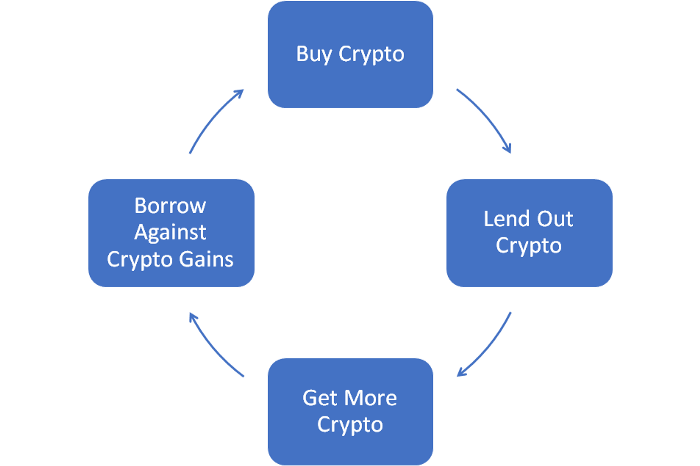
This is normal human behavior. If not for credit limits, credit scores, and government regulations, people would do this with money from the banks.
Eventually, you’ll start to see people advertising their “master plan” for using DeFi to make fast money with crypto. You’ll hear stories from friends and strangers about DeFi millionaires and people who got rich from yield farming. That could be you!
How many people do you know will turn down money from nothing?
Liquidity trap = Fresh capital
Thanks to big stimulus packages, zero and negative interest rates, and a poor business environment, investors don’t have any good ways to make money anymore. Traditional investments involve more risk and lower returns than ever before.
Equities are overvalued and many companies have slashed dividends. Cash and bonds earn almost nothing. Private equity deals are hard to come by — and nobody knows how these start-ups will survive COVID-19.
Yet, U.S. investment firms have $26 trillion in assets under management and, based on U.S. Federal Reserve data, U.S. households have more than $18 trillion in cash, savings, and money market accounts. A similar situation exists in other countries, too, albeit on a smaller scale. On top of that, global funds, foreign investors, and offshore accounts hold upwards of $40 trillion.
None of that money has to go into crypto, but some of it will — once prices start going up long enough for people to believe prices will keep going up.
Again, normal human behavior. Nobody has the patience and discipline to continue losing money with cash, stocks, and bonds while cryptocurrency prices explode.
Show me the data
I can’t. Nobody can. Every data model has a data model that contradicts it.Even S2F (and all its permutations).
Predicting the future is hard, even if you know what’s going to happen!
My prediction does not depend on statistical projections. It’s based on history and psychology. I’m taking thousands of years of data on humans, eleven years of data on bitcoin, and projecting a result.
Some may want to compare this next bull market to the 2017 mania.
I’d caution against that. Cryptocurrency is more professional, regulated, mature, and functional than in 2017. Back then, you had a bunch of white papers and shills. Now, you have real products and services built on top of bitcoin’s protocol or constructed with altcoins.
With Cardano, Waves, ETH 2.0, NEO 3.0, XTZ, and other smart contracts platforms creating new opportunities for developers while DeFi offers massive liquidity pools for smart money and financial engineers, you finally have an opportunity that seems “real,” not a bunch of scams and Ponzi schemes.
Tokenomic models have improved, too.
Many cryptocurrencies now recognize the importance of staking and bonding, two actions that essentially lock-up token supply and encourage HODLing. As a result, market participants have less pressure to sell out of projects as prices rise. Prices will get higher for longer before early investors dump their tokens.
While these developments mostly apply to altcoins, they will contribute to the overall positive sentiment, which will rub off on bitcoin.
When will bitcoin hit its market cycle peak?
Around October 2022.
Here’s the thinking behind that prediction.
It took 24 months for bitcoin to go from its low of November 2011 to its high of November 2013. It took 35 months for bitcoin to go from its low of January 2015 to its high of December 17.
Extend that pattern and we can predict it will take 46 months for bitcoin to go from its low of January 2019 to its high in October 2022. Like so:
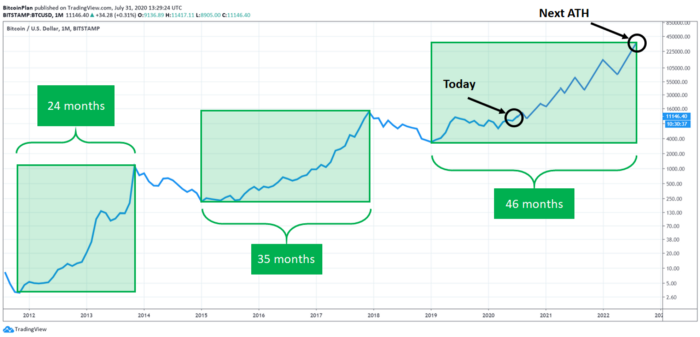
Of course, that’s like rolling a die and turning up 1, rolling again and turning up 2, and predicting the next roll will be 3. Bad statistics, but it’s as good as any of the other projections people are making.
From another viewpoint
As an alternative, let’s look at a different way to think about market cycles, called Elliott Wave Theory (EW). I wrote a more detailed post about this in February but I’ll summarize it here.
Basically, EW claims markets move in five waves: up, down (but not that much), up, down (but not that much), up. You can mark these as 1–2–3–4–5. Waves 1 and 5 are usually the shortest, with wave 3 the longest.
After that fifth wave, prices drop a lot for a while, in three waves: down quickly, up quickly, then down slowly. You can mark these as a-b-c.
They look like this on a price chart, courtesy of Investopedia:
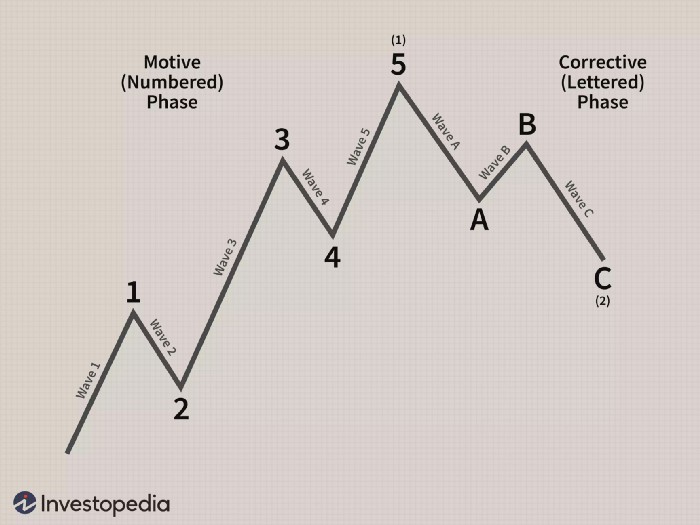
After the c wave, you start the cycle again. Now look at bitcoin’s long-term price chart:
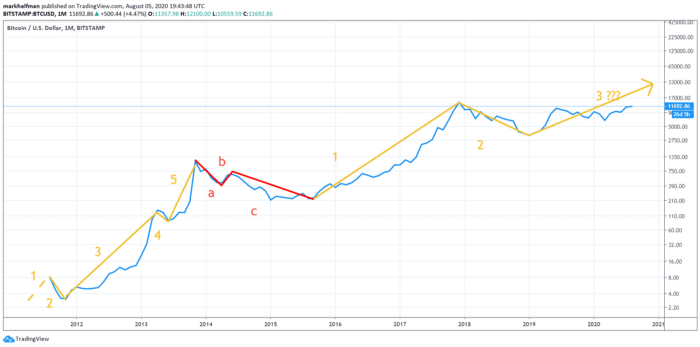
Some, like Ross Ulbricht, apply EW differently:
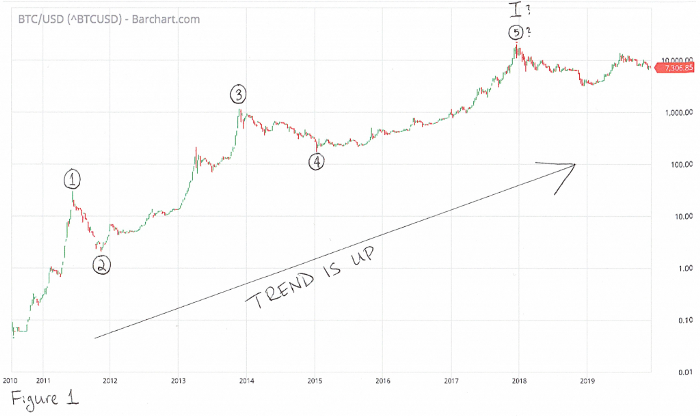
That’s fine, it gets us the same result. I looked at history, he looked at a price chart.
There’s a certain psychology behind the waves. During the up-waves, people are largely optimistic. Even during the second and fourth down-waves, core believers remain positive despite falling prices.
Once you get to the end of that fifth wave, the corrective waves destroy optimism. Even the core believers sell out of the market or resign themselves to their losses. New buyers scoop up assets at basement prices. Then the cycle starts again.
When analyzing the chart, you can make the case for 2009–2013 as the first five-wave cycle and 2013–2015 as the corrective a-b-c waves.
- Wave 1 — only OGs did bitcoin. Nobody else cared, and many laughed them off.
- Wave 2 — first crash.
- Wave 3 — OGs bounced back and new buyers/miners started getting into it. Price went absolutely insane. Mt. Gox made it easy for people to buy bitcoin while silk road offered the first real-world use case.
- Wave 4 — second crash, silk road got busted.
- Wave 5 — one last surge.
Then, we got the Mt. Gox disaster, the silk road leaders went to jail, and the U.S. government sold their bitcoin for pennies on the dollar. Everybody capitulated. People thought bitcoin was dead. Many gave up. Some threw away their hard drives and abandoned their wallets. Development almost stopped — in fact, some of the best developers started new blockchains like Ethereum and NEO.
By the end of 2015, prices bottomed and we started another cycle, with wave 1 completing in January 2018 and wave 2 completing in early 2019. People are still enthusiastic, development continues to grow, and traditional financial firms are geared up to enter the markets (some already did). Many remain confident that bitcoin would go up.
If that’s true, we’re in the third wave of bitcoin’s second five-wave cycle — the longest, strongest wave.
As the longest, strongest wave, it should last longer than wave 1, which lasted 35 months. 46 months seems like a good guess.
Biggest bull market ever?
If that theory’s correct, there’s one detail that blows my mind.
Each time we reached a previous all-time high, we got there around the middle of the wave, maybe closer to 60% of the way through. Like so:
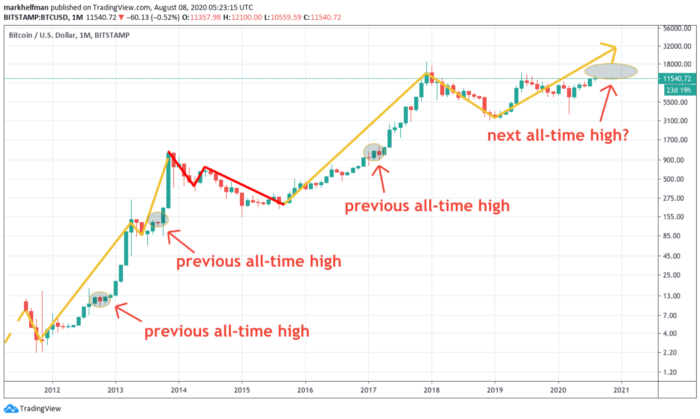
If that pattern holds on this fourth go-round, it suggests we could have two more years of a bull market after we hit $20,000.
Guess what?
We still haven’t hit $20,000.



